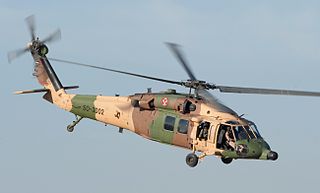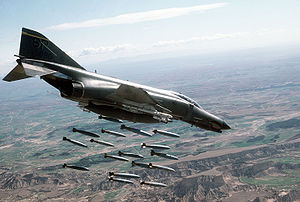
A bomber is a military combat aircraft designed to attack ground and naval targets by dropping air-to-ground weaponry, launching torpedoes, or deploying air-launched cruise missiles. The first use of bombs dropped from an aircraft occurred in the Italo-Turkish War, with the first major deployments coming in the First World War and Second World War by all major airforces causing devastating damage to cities, towns, and rural areas. The first purpose built bombers were the Italian Caproni Ca 30 and British Bristol T.B.8, both of 1913. Some bombers were decorated with nose art or victory markings.
The United States Armed Forces are the military forces of the United States. The armed forces consists of six service branches: the Army, Marine Corps, Navy, Air Force, Space Force, and Coast Guard. All six armed services are among the eight uniformed services of the United States.

A military aircraft is any fixed-wing or rotary-wing aircraft that is operated by a legal or insurrectionary military of any type. Military aircraft can be either combat or non-combat:

Anti-aircraft warfare, counter-air, anti-air, AA guns, layered air defence or air defence forces is the battlespace response to aerial warfare, defined by NATO as "all measures designed to nullify or reduce the effectiveness of hostile air action". It includes surface based, subsurface, and air-based weapon systems, associated sensor systems, command and control arrangements, and passive measures. It may be used to protect naval, ground, and air forces in any location. However, for most countries, the main effort has tended to be homeland defence. NATO refers to airborne air defence as counter-air and naval air defence as anti-aircraft warfare. Missile defence is an extension of air defence, as are initiatives to adapt air defence to the task of intercepting any projectile in flight.

A light bomber is a relatively small and fast type of military bomber aircraft that was primarily employed before the 1950s. Such aircraft would typically not carry more than one ton of ordnance.

An airstrike, air strike, or air raid is an offensive operation carried out by aircraft. Air strikes are delivered from aircraft such as blimps, balloons, fighter aircraft, attack aircraft, bombers, attack helicopters, and drones. The official definition includes all sorts of targets, including enemy air targets, but in popular usage the term is usually narrowed to a tactical (small-scale) attack on a ground or naval objective as opposed to a larger, more general attack such as carpet bombing. Weapons used in an airstrike can range from direct-fire aircraft-mounted cannons and machine guns, rockets and air-to-surface missiles, to various types of aerial bombs, glide bombs, cruise missiles, ballistic missiles, and even directed-energy weapons such as laser weapons.

Suppression of Enemy Air Defenses (SEAD, pronounced ), also known in the United States as "Wild Weasel" and (initially) "Iron Hand" operations, are military actions to suppress enemy surface-based air defenses, including not only surface-to-air missiles (SAMs) and anti-aircraft artillery (AAA) but also interrelated systems such as early-warning radar and command, control and communication (C3) functions, while also marking other targets to be destroyed by an air strike. Suppression can be accomplished both by physically destroying the systems or by disrupting and deceiving them through electronic warfare. In modern warfare, SEAD missions can constitute as much as 30% of all sorties launched in the first week of combat and continue at a reduced rate through the rest of a campaign. One quarter of American combat sorties in recent conflicts have been SEAD missions. Despite generally being associated with aircraft, SEAD missions may be performed using any means, including through actions by ground forces.

In military tactics, close air support (CAS) is defined as aerial warfare actions—often air-to-ground actions such as strafes or airstrikes—by military aircraft against hostile targets in close proximity to friendly forces. A form of fire support, CAS requires detailed integration of each air mission with fire and movement of all forces involved. CAS may be conducted using aerial bombs, glide bombs, missiles, rockets, autocannons, machine guns, and even directed-energy weapons such as lasers.

The history of aerial warfare began in ancient times, with the use of kites in China. In the third century, it progressed to balloon warfare. Airplanes were put to use for war starting in 1911, initially for reconnaissance, and then for aerial combat to shoot down the recon planes. The use of planes for strategic bombing emerged during World War II. Also during World War II, Nazi Germany developed many missile and precision-guided munition systems, including the first cruise missile, the first short-range ballistic missile, the first guided surface-to-air missiles, and the first anti-ship missiles. Ballistic missiles became of key importance during the Cold War, were armed with nuclear warheads, and were stockpiled by the superpowers – the United States and the Soviet Union – to deter each other from using them.

World War I was the first major conflict involving the large-scale use of aircraft. Tethered observation balloons had already been employed in several wars, and would be used extensively for artillery spotting. Germany employed Zeppelins for reconnaissance over the North Sea and Baltic and also for strategic bombing raids over Britain and the Eastern Front.

Military aviation comprises military aircraft and other flying machines for the purposes of conducting or enabling aerial warfare, including national airlift capacity to provide logistical supply to forces stationed in a war theater or along a front. Airpower includes the national means of conducting such warfare, including the intersection of transport and warcraft. Military aircraft include bombers, fighters, transports, trainer aircraft, and reconnaissance aircraft.

An army aviation unit is an aviation-related unit of a nation's army, sometimes described as an air corps. These units are generally separate from a nation's dedicated air force, and usually comprise helicopters and light support fixed-wing aircraft. Prior to the establishment of separate national air forces, many armies had military aviation units, which as the importance of aviation increased, were spun off into independent services. As the separation between a nation's army and air force led to a divergence of priorities, many armies sought to re-establish their own aviation branches to best serve their own organic tactical needs.

Unmanned Aerial Vehicles (UAVs) include both autonomous drones and remotely piloted vehicles (RPVs). A UAV is capable of controlled, sustained level flight and is powered by a jet, reciprocating, or electric engine. In the twenty-first century, technology reached a point of sophistication that the UAV is now being given a greatly expanded role in many areas of aviation.

The history of unmanned combat aerial vehicles (UCAVs) is closely tied to the general history of unmanned aerial vehicles (UAVs). While the technology dates back at least as far as the 1940s, common usage in live operations came in the 2000s. UCAVs have now become an important part of modern warfare, including in the Syrian civil war, the 2020 Nagorno-Karabakh war and during the 2022 Russian invasion of Ukraine.

The 55th Operations Group is a component of the 55th Wing, assigned to the United States Air Force Air Combat Command. The group is stationed at Offut Air Force Base, Nebraska.

Anti-surface warfare is the branch of naval warfare concerned with the suppression of surface combatants. More generally, it is any weapons, sensors, or operations intended to attack or limit the effectiveness of an adversary's surface ships. Before the adoption of the submarine and naval aviation, all naval warfare consisted of anti-surface warfare. The distinct concept of an anti-surface warfare capability emerged after World War II, and literature on the subject as a distinct discipline is inherently dominated by the dynamics of the Cold War.

A military helicopter is a helicopter that is either specifically built or converted for use by military forces. A military helicopter's mission is a function of its design or conversion. The most common use of military helicopters is transport of troops, but transport helicopters can be modified or converted to perform other missions such as combat search and rescue (CSAR), medical evacuation (MEDEVAC), airborne command post, or even armed with weapons for attacking ground targets. Specialized military helicopters are intended to conduct specific missions. Examples of specialized military helicopters are attack helicopters, observation helicopters and anti-submarine warfare (ASW) helicopters.

Aerial reconnaissance is reconnaissance for a military or strategic purpose that is conducted using reconnaissance aircraft. The role of reconnaissance can fulfil a variety of requirements including artillery spotting, the collection of imagery intelligence, and the observation of enemy maneuvers.

Air warfare was a major component in all theaters of World War II and, together with anti-aircraft warfare, consumed a large fraction of the industrial output of the major powers. Germany and Japan depended on air forces that were closely integrated with land and naval forces; the Axis powers downplayed the advantage of fleets of strategic bombers and were late in appreciating the need to defend against Allied strategic bombing. By contrast, Britain and the United States took an approach that greatly emphasized strategic bombing and tactical control of the battlefield by air as well as adequate air defenses. Both Britain and the U.S. built substantially larger strategic forces of large, long-range bombers. Simultaneously, they built tactical air forces that could win air superiority over the battlefields, thereby giving vital assistance to ground troops. The U.S. Navy and Royal Navy also built a powerful naval-air component based on aircraft carriers, as did the Imperial Japanese Navy; these played the central role in the war at sea.

An air force in the broadest sense is the national military branch that primarily conducts aerial warfare. More specifically, it is the branch of a nation's armed services that is responsible for aerial warfare as distinct from an army aviation or naval aviation units. Typically, air forces are responsible for gaining control of the air, carrying out strategic and tactical bombing missions, and providing support to land and naval forces often in the form of aerial reconnaissance and close air support.




















